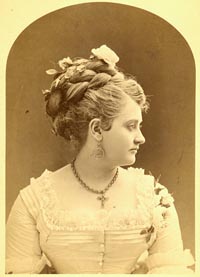In the 1870s, San Francisco was the center of advanced photography in the United States. The most renowned portrait photographers in San Francisco were the studio of Bradley & Rulofson. Every visiting celebrity, statesman — Kings, Presidents, Theatre Stars — had their portrait taken by B&R. Around 1872 B&R took a series of portraits of a beautiful woman which they considered to be their most artistic work ever. They sent six prints to The Philadelphia Photographer, the most important U.S. periodical on the subject, which published them and awarded their 1874 “Gold Medal” to B&R for them.
 Although
she was not named in the article, the model in the portraits has been
identified by several scholars (Robert Bartlett Haas, George Hendricks,
Stanford Library) as Flora
Muybridge, wife of B&R photographer Eadweard Muybridge. This
identification has been questioned by Nick Wright. His extensive research
establishes that the woman in the picture was Australian actress Minnie Walton. Both
Flora and Minnie died, tragically, in their 20s.
Although
she was not named in the article, the model in the portraits has been
identified by several scholars (Robert Bartlett Haas, George Hendricks,
Stanford Library) as Flora
Muybridge, wife of B&R photographer Eadweard Muybridge. This
identification has been questioned by Nick Wright. His extensive research
establishes that the woman in the picture was Australian actress Minnie Walton. Both
Flora and Minnie died, tragically, in their 20s.
Flora was widely regarded as the most beautiful woman in San Francisco, at a time when many people, certainly including artists, preferred a more rounded figure than they seem to today.
Flora was at the center of a love triangle and a spectacular murder trial when her husband discovered she had been unfaithful and killed her lover, Major Harry Larkyns.
Whether Flora or Minnie, this portrait represents an important piece of history, and is certainly one of the most important photographic portraits of the 1870s. It was made with great care, using the finest techniques, paper, and chemicals. Like most prints of its time, before the widespread use of enlargers, it is a contact print the exact size (3.5" x 5.5") of those that were sent to Philadelphia. An exquisite patina has developed in the albumen over the past 150 years – it is truly a gold medal picture.
The story of Flora and Ted, and much more, is found in Freezing Time: the Autobiography of Eadweard Muybridge.



